Early Childhood Education and Care: Experience Plans for Child Emma
VerifiedAdded on 2023/06/03
|10
|1605
|201
Practical Assignment
AI Summary
This document presents three detailed experience plans designed for early childhood education and care, focusing on a child named Emma. The first plan centers on learning the alphabet using a puzzle board, aligning with EYLF outcome 4, which emphasizes curiosity and enthusiasm. The second plan involves bubble wrap stomp painting to enhance gross and fine motor skills, linking to EYLF outcome 3, which focuses on social and emotional wellbeing, and outcome 3.2, which emphasizes physical wellbeing. The third plan incorporates gardening activities to teach about flowers, fruits, and the importance of the environment, connecting with EYLF outcomes 2.1 and 2.2, which address community belonging and respect for diversity. Each plan includes rationale, learning outcomes, materials, engagement ideas, EYLF principles and practices, and intended teaching strategies to support the child's development.
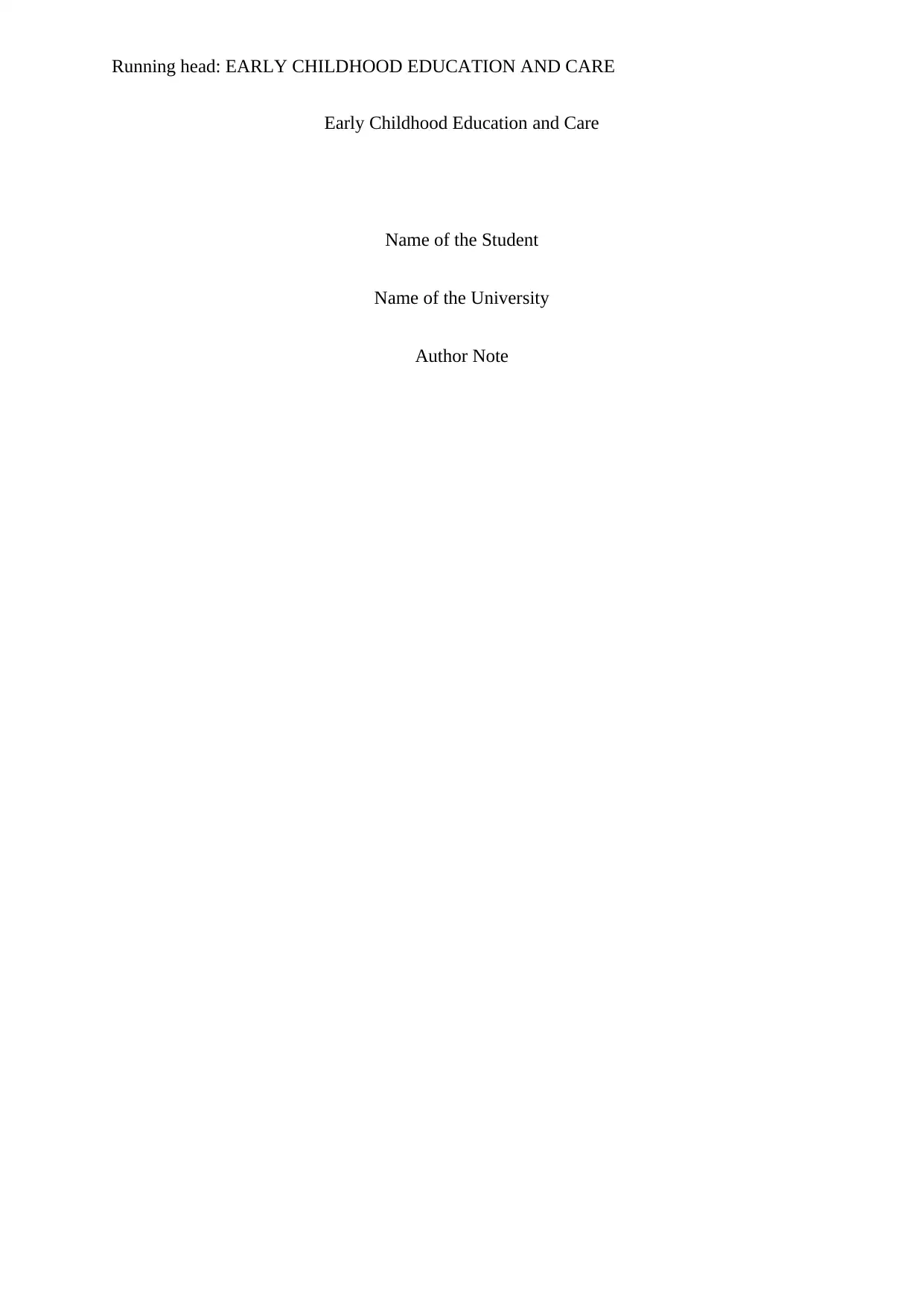
Running head: EARLY CHILDHOOD EDUCATION AND CARE
Early Childhood Education and Care
Name of the Student
Name of the University
Author Note
Early Childhood Education and Care
Name of the Student
Name of the University
Author Note
Paraphrase This Document
Need a fresh take? Get an instant paraphrase of this document with our AI Paraphraser
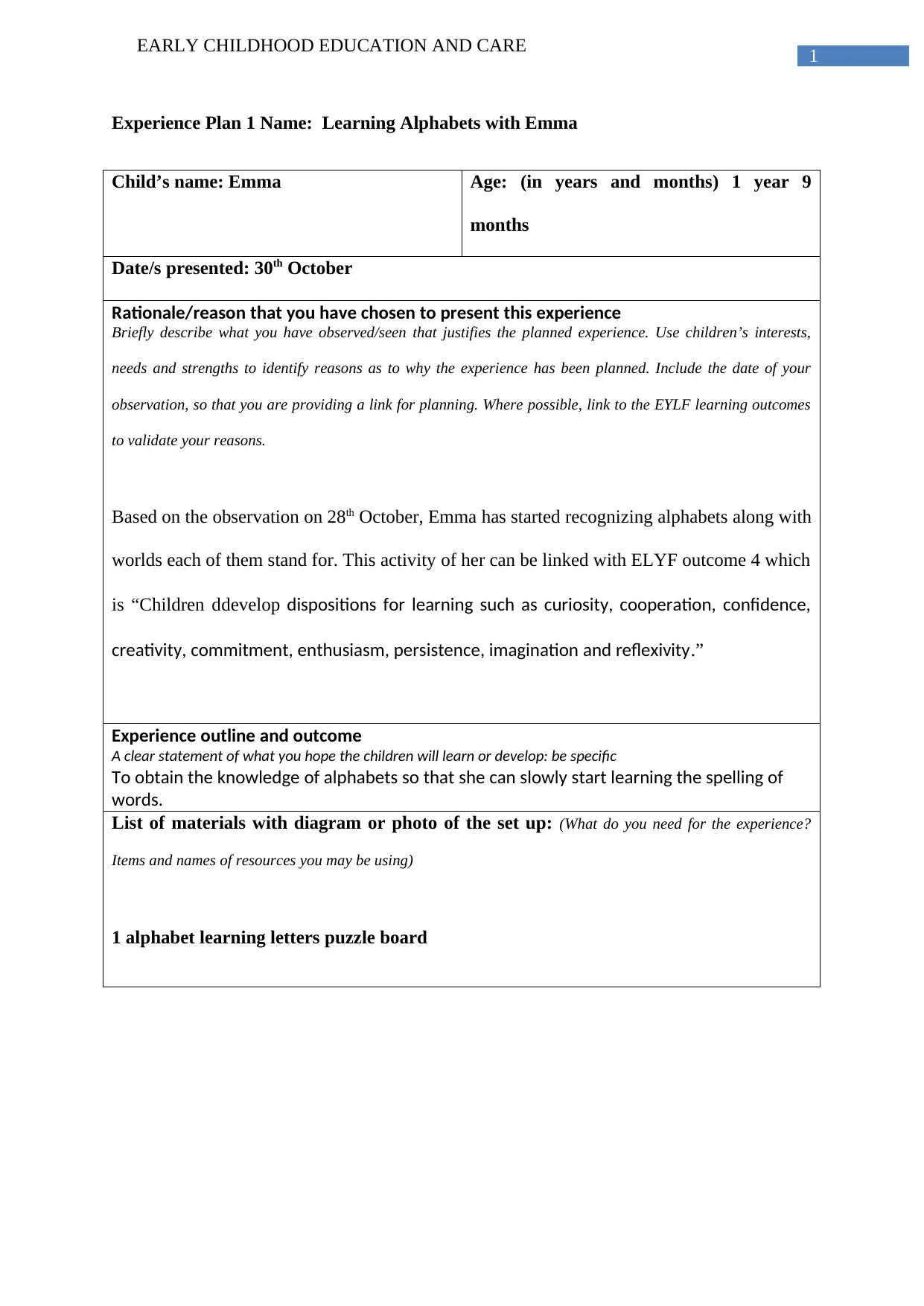
1
EARLY CHILDHOOD EDUCATION AND CARE
Experience Plan 1 Name: Learning Alphabets with Emma
Child’s name: Emma Age: (in years and months) 1 year 9
months
Date/s presented: 30th October
Rationale/reason that you have chosen to present this experience
Briefly describe what you have observed/seen that justifies the planned experience. Use children’s interests,
needs and strengths to identify reasons as to why the experience has been planned. Include the date of your
observation, so that you are providing a link for planning. Where possible, link to the EYLF learning outcomes
to validate your reasons.
Based on the observation on 28th October, Emma has started recognizing alphabets along with
worlds each of them stand for. This activity of her can be linked with ELYF outcome 4 which
is “Children ddevelop dispositions for learning such as curiosity, cooperation, confidence,
creativity, commitment, enthusiasm, persistence, imagination and reflexivity.”
Experience outline and outcome
A clear statement of what you hope the children will learn or develop: be specific
To obtain the knowledge of alphabets so that she can slowly start learning the spelling of
words.
List of materials with diagram or photo of the set up: (What do you need for the experience?
Items and names of resources you may be using)
1 alphabet learning letters puzzle board
EARLY CHILDHOOD EDUCATION AND CARE
Experience Plan 1 Name: Learning Alphabets with Emma
Child’s name: Emma Age: (in years and months) 1 year 9
months
Date/s presented: 30th October
Rationale/reason that you have chosen to present this experience
Briefly describe what you have observed/seen that justifies the planned experience. Use children’s interests,
needs and strengths to identify reasons as to why the experience has been planned. Include the date of your
observation, so that you are providing a link for planning. Where possible, link to the EYLF learning outcomes
to validate your reasons.
Based on the observation on 28th October, Emma has started recognizing alphabets along with
worlds each of them stand for. This activity of her can be linked with ELYF outcome 4 which
is “Children ddevelop dispositions for learning such as curiosity, cooperation, confidence,
creativity, commitment, enthusiasm, persistence, imagination and reflexivity.”
Experience outline and outcome
A clear statement of what you hope the children will learn or develop: be specific
To obtain the knowledge of alphabets so that she can slowly start learning the spelling of
words.
List of materials with diagram or photo of the set up: (What do you need for the experience?
Items and names of resources you may be using)
1 alphabet learning letters puzzle board
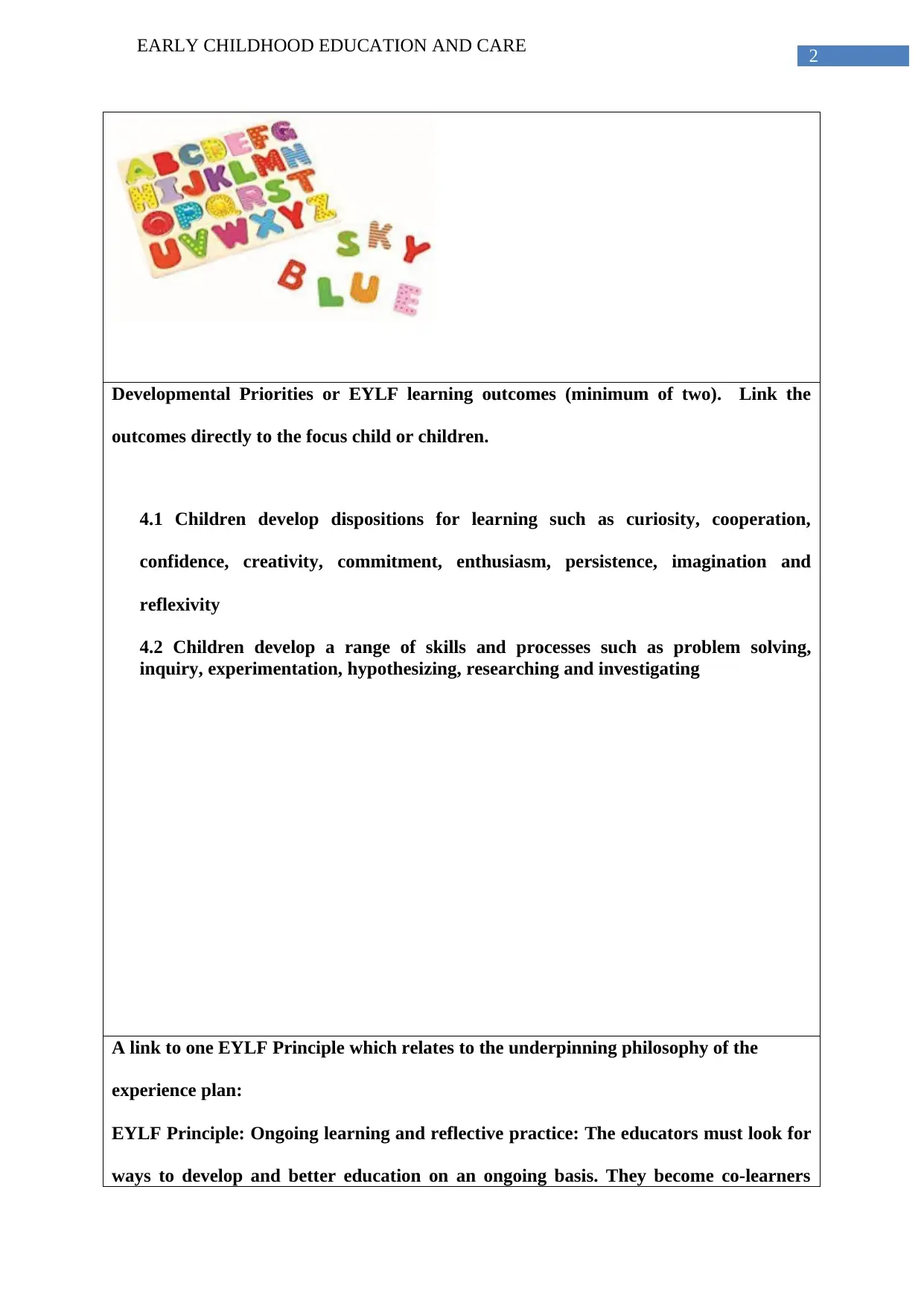
2
EARLY CHILDHOOD EDUCATION AND CARE
Developmental Priorities or EYLF learning outcomes (minimum of two). Link the
outcomes directly to the focus child or children.
4.1 Children develop dispositions for learning such as curiosity, cooperation,
confidence, creativity, commitment, enthusiasm, persistence, imagination and
reflexivity
4.2 Children develop a range of skills and processes such as problem solving,
inquiry, experimentation, hypothesizing, researching and investigating
A link to one EYLF Principle which relates to the underpinning philosophy of the
experience plan:
EYLF Principle: Ongoing learning and reflective practice: The educators must look for
ways to develop and better education on an ongoing basis. They become co-learners
EARLY CHILDHOOD EDUCATION AND CARE
Developmental Priorities or EYLF learning outcomes (minimum of two). Link the
outcomes directly to the focus child or children.
4.1 Children develop dispositions for learning such as curiosity, cooperation,
confidence, creativity, commitment, enthusiasm, persistence, imagination and
reflexivity
4.2 Children develop a range of skills and processes such as problem solving,
inquiry, experimentation, hypothesizing, researching and investigating
A link to one EYLF Principle which relates to the underpinning philosophy of the
experience plan:
EYLF Principle: Ongoing learning and reflective practice: The educators must look for
ways to develop and better education on an ongoing basis. They become co-learners
⊘ This is a preview!⊘
Do you want full access?
Subscribe today to unlock all pages.

Trusted by 1+ million students worldwide
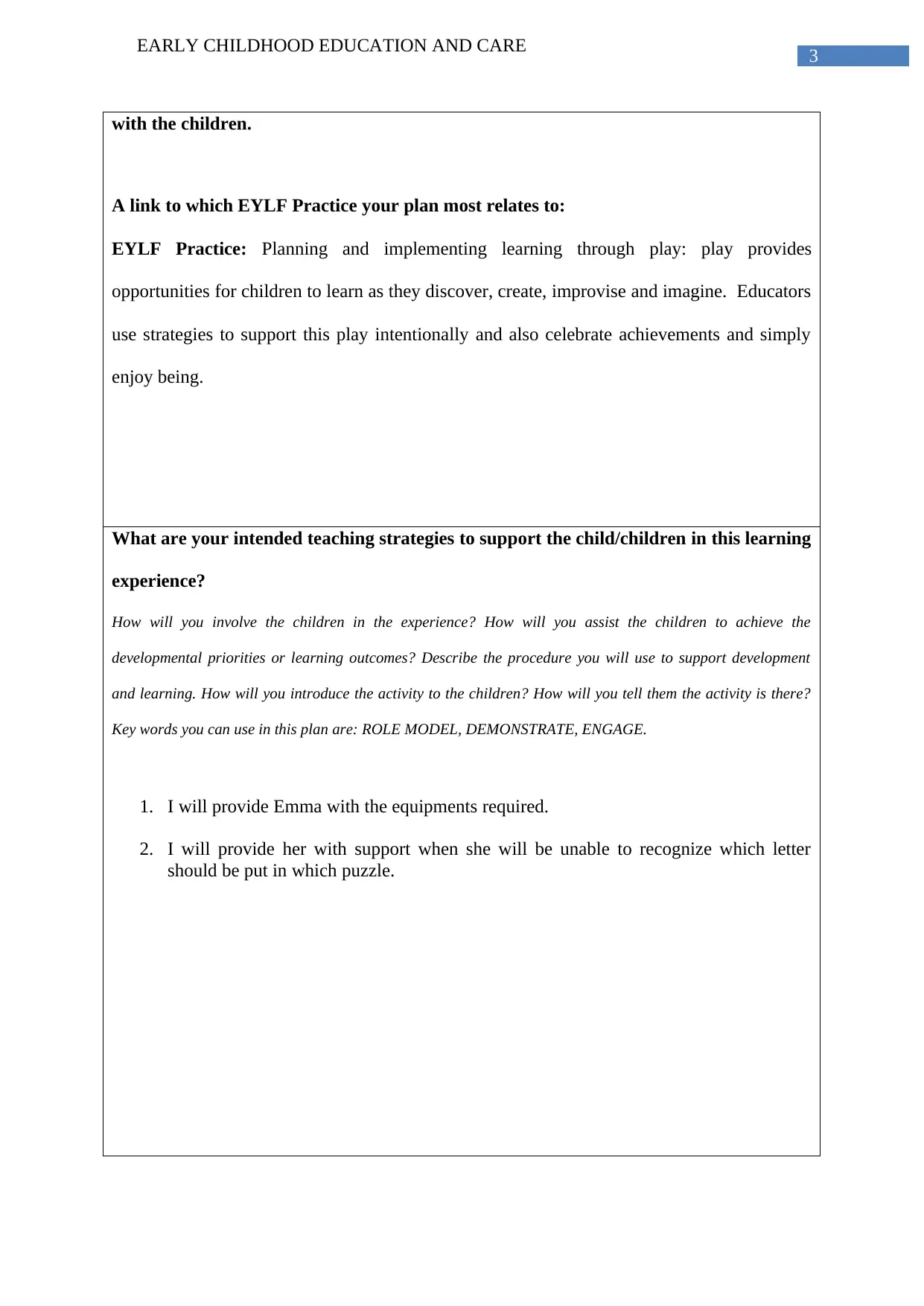
3
EARLY CHILDHOOD EDUCATION AND CARE
with the children.
A link to which EYLF Practice your plan most relates to:
EYLF Practice: Planning and implementing learning through play: play provides
opportunities for children to learn as they discover, create, improvise and imagine. Educators
use strategies to support this play intentionally and also celebrate achievements and simply
enjoy being.
What are your intended teaching strategies to support the child/children in this learning
experience?
How will you involve the children in the experience? How will you assist the children to achieve the
developmental priorities or learning outcomes? Describe the procedure you will use to support development
and learning. How will you introduce the activity to the children? How will you tell them the activity is there?
Key words you can use in this plan are: ROLE MODEL, DEMONSTRATE, ENGAGE.
1. I will provide Emma with the equipments required.
2. I will provide her with support when she will be unable to recognize which letter
should be put in which puzzle.
EARLY CHILDHOOD EDUCATION AND CARE
with the children.
A link to which EYLF Practice your plan most relates to:
EYLF Practice: Planning and implementing learning through play: play provides
opportunities for children to learn as they discover, create, improvise and imagine. Educators
use strategies to support this play intentionally and also celebrate achievements and simply
enjoy being.
What are your intended teaching strategies to support the child/children in this learning
experience?
How will you involve the children in the experience? How will you assist the children to achieve the
developmental priorities or learning outcomes? Describe the procedure you will use to support development
and learning. How will you introduce the activity to the children? How will you tell them the activity is there?
Key words you can use in this plan are: ROLE MODEL, DEMONSTRATE, ENGAGE.
1. I will provide Emma with the equipments required.
2. I will provide her with support when she will be unable to recognize which letter
should be put in which puzzle.
Paraphrase This Document
Need a fresh take? Get an instant paraphrase of this document with our AI Paraphraser
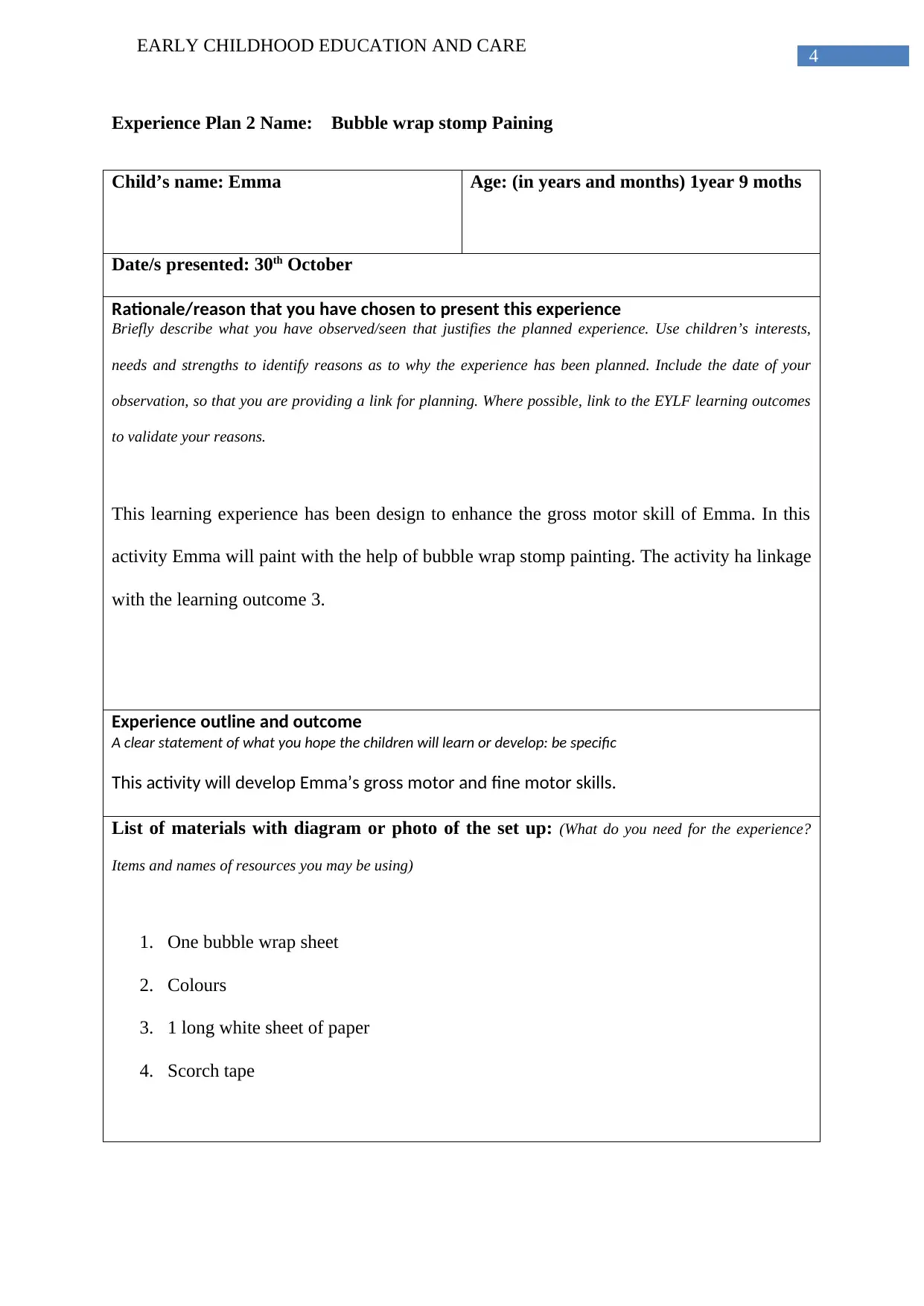
4
EARLY CHILDHOOD EDUCATION AND CARE
Experience Plan 2 Name: Bubble wrap stomp Paining
Child’s name: Emma Age: (in years and months) 1year 9 moths
Date/s presented: 30th October
Rationale/reason that you have chosen to present this experience
Briefly describe what you have observed/seen that justifies the planned experience. Use children’s interests,
needs and strengths to identify reasons as to why the experience has been planned. Include the date of your
observation, so that you are providing a link for planning. Where possible, link to the EYLF learning outcomes
to validate your reasons.
This learning experience has been design to enhance the gross motor skill of Emma. In this
activity Emma will paint with the help of bubble wrap stomp painting. The activity ha linkage
with the learning outcome 3.
Experience outline and outcome
A clear statement of what you hope the children will learn or develop: be specific
This activity will develop Emma’s gross motor and fine motor skills.
List of materials with diagram or photo of the set up: (What do you need for the experience?
Items and names of resources you may be using)
1. One bubble wrap sheet
2. Colours
3. 1 long white sheet of paper
4. Scorch tape
EARLY CHILDHOOD EDUCATION AND CARE
Experience Plan 2 Name: Bubble wrap stomp Paining
Child’s name: Emma Age: (in years and months) 1year 9 moths
Date/s presented: 30th October
Rationale/reason that you have chosen to present this experience
Briefly describe what you have observed/seen that justifies the planned experience. Use children’s interests,
needs and strengths to identify reasons as to why the experience has been planned. Include the date of your
observation, so that you are providing a link for planning. Where possible, link to the EYLF learning outcomes
to validate your reasons.
This learning experience has been design to enhance the gross motor skill of Emma. In this
activity Emma will paint with the help of bubble wrap stomp painting. The activity ha linkage
with the learning outcome 3.
Experience outline and outcome
A clear statement of what you hope the children will learn or develop: be specific
This activity will develop Emma’s gross motor and fine motor skills.
List of materials with diagram or photo of the set up: (What do you need for the experience?
Items and names of resources you may be using)
1. One bubble wrap sheet
2. Colours
3. 1 long white sheet of paper
4. Scorch tape
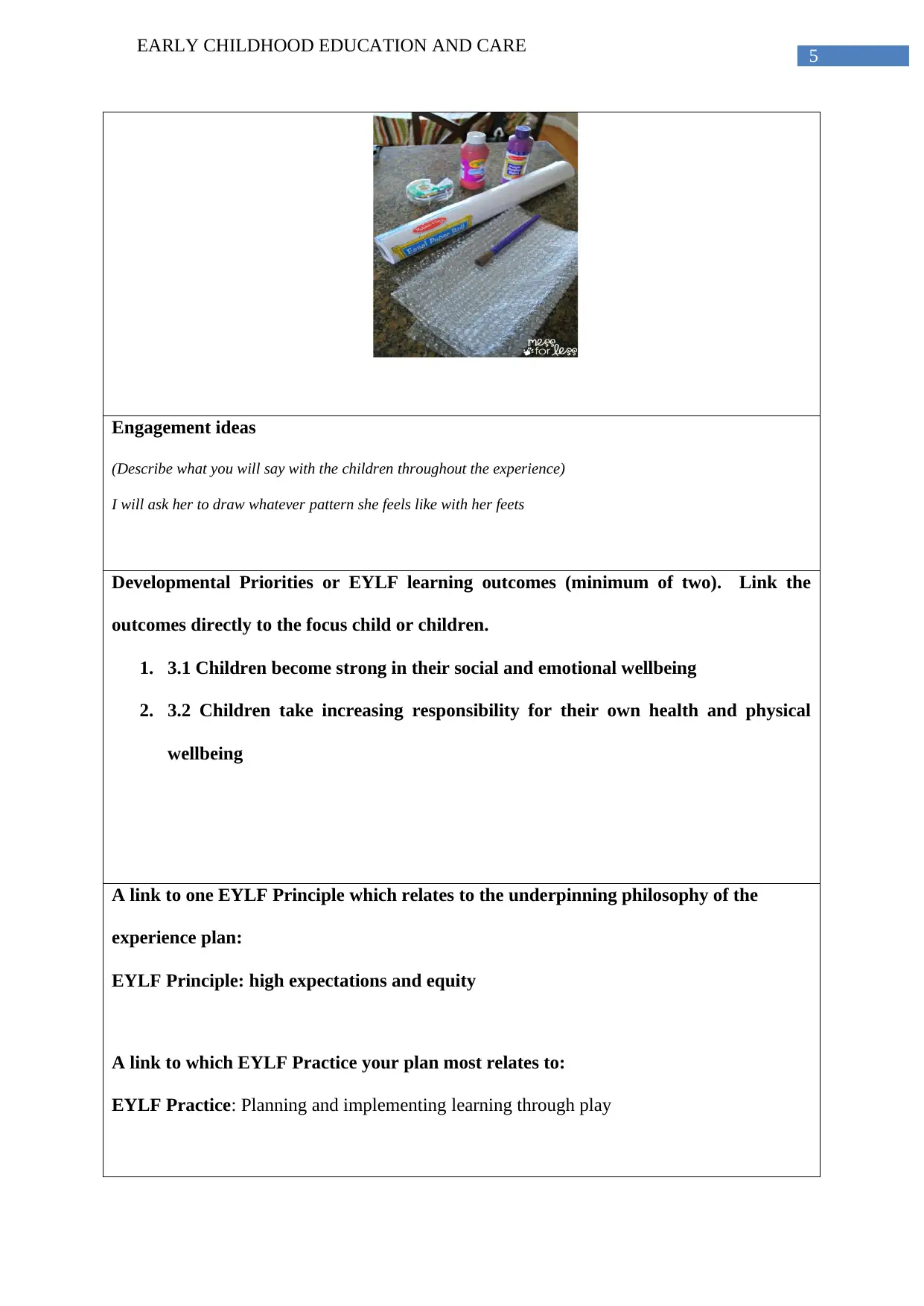
5
EARLY CHILDHOOD EDUCATION AND CARE
Engagement ideas
(Describe what you will say with the children throughout the experience)
I will ask her to draw whatever pattern she feels like with her feets
Developmental Priorities or EYLF learning outcomes (minimum of two). Link the
outcomes directly to the focus child or children.
1. 3.1 Children become strong in their social and emotional wellbeing
2. 3.2 Children take increasing responsibility for their own health and physical
wellbeing
A link to one EYLF Principle which relates to the underpinning philosophy of the
experience plan:
EYLF Principle: high expectations and equity
A link to which EYLF Practice your plan most relates to:
EYLF Practice: Planning and implementing learning through play
EARLY CHILDHOOD EDUCATION AND CARE
Engagement ideas
(Describe what you will say with the children throughout the experience)
I will ask her to draw whatever pattern she feels like with her feets
Developmental Priorities or EYLF learning outcomes (minimum of two). Link the
outcomes directly to the focus child or children.
1. 3.1 Children become strong in their social and emotional wellbeing
2. 3.2 Children take increasing responsibility for their own health and physical
wellbeing
A link to one EYLF Principle which relates to the underpinning philosophy of the
experience plan:
EYLF Principle: high expectations and equity
A link to which EYLF Practice your plan most relates to:
EYLF Practice: Planning and implementing learning through play
⊘ This is a preview!⊘
Do you want full access?
Subscribe today to unlock all pages.

Trusted by 1+ million students worldwide
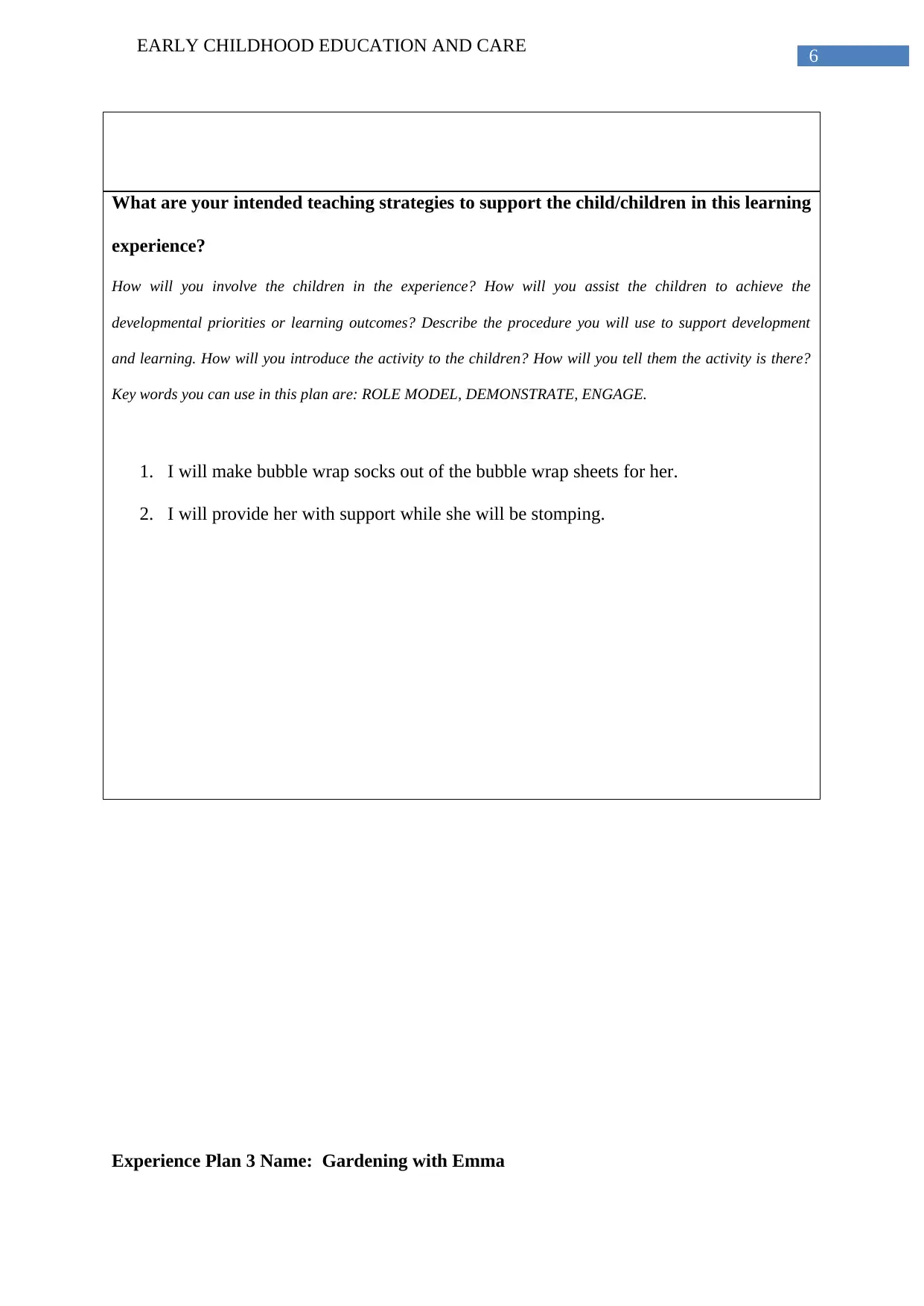
6
EARLY CHILDHOOD EDUCATION AND CARE
What are your intended teaching strategies to support the child/children in this learning
experience?
How will you involve the children in the experience? How will you assist the children to achieve the
developmental priorities or learning outcomes? Describe the procedure you will use to support development
and learning. How will you introduce the activity to the children? How will you tell them the activity is there?
Key words you can use in this plan are: ROLE MODEL, DEMONSTRATE, ENGAGE.
1. I will make bubble wrap socks out of the bubble wrap sheets for her.
2. I will provide her with support while she will be stomping.
Experience Plan 3 Name: Gardening with Emma
EARLY CHILDHOOD EDUCATION AND CARE
What are your intended teaching strategies to support the child/children in this learning
experience?
How will you involve the children in the experience? How will you assist the children to achieve the
developmental priorities or learning outcomes? Describe the procedure you will use to support development
and learning. How will you introduce the activity to the children? How will you tell them the activity is there?
Key words you can use in this plan are: ROLE MODEL, DEMONSTRATE, ENGAGE.
1. I will make bubble wrap socks out of the bubble wrap sheets for her.
2. I will provide her with support while she will be stomping.
Experience Plan 3 Name: Gardening with Emma
Paraphrase This Document
Need a fresh take? Get an instant paraphrase of this document with our AI Paraphraser
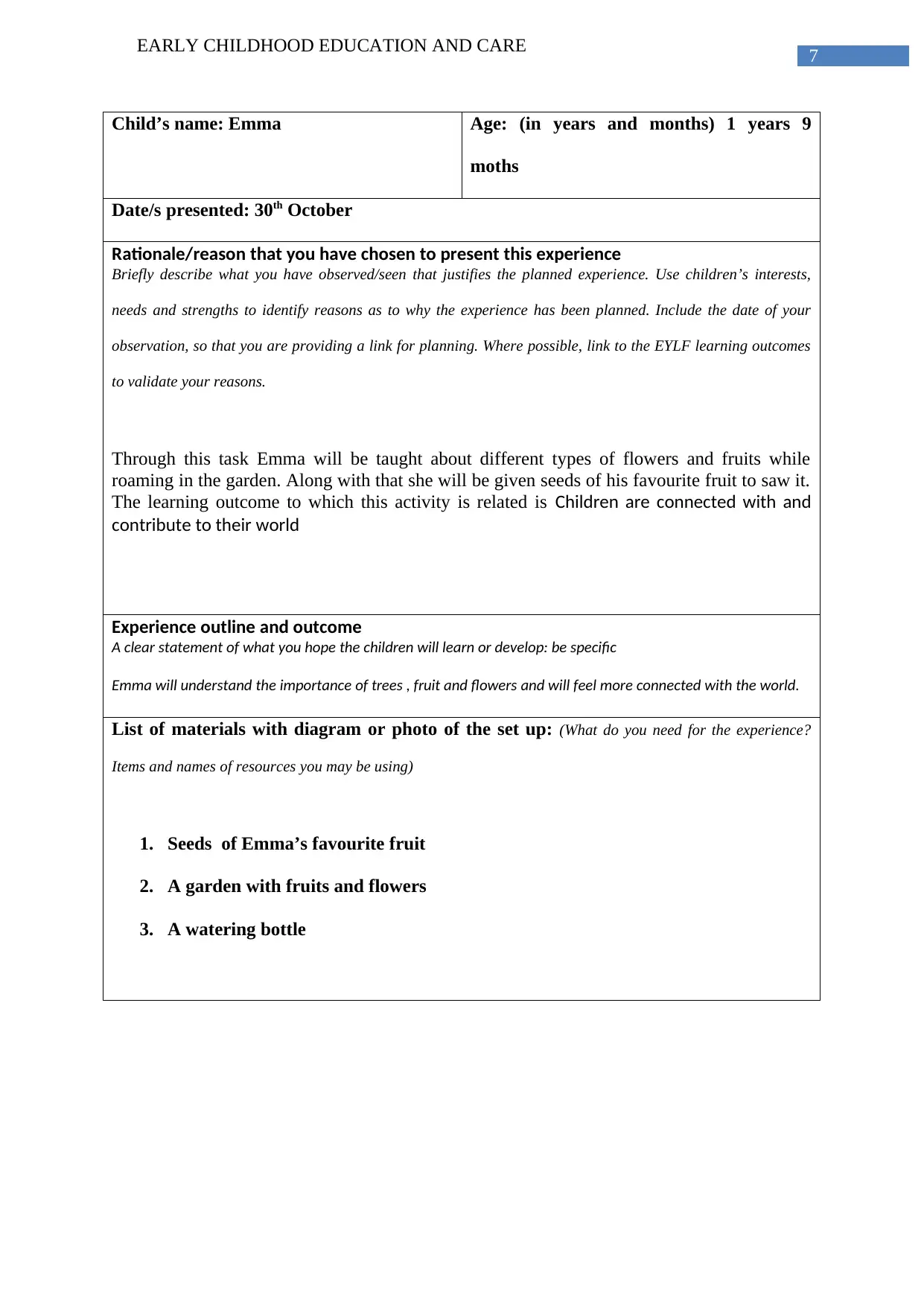
7
EARLY CHILDHOOD EDUCATION AND CARE
Child’s name: Emma Age: (in years and months) 1 years 9
moths
Date/s presented: 30th October
Rationale/reason that you have chosen to present this experience
Briefly describe what you have observed/seen that justifies the planned experience. Use children’s interests,
needs and strengths to identify reasons as to why the experience has been planned. Include the date of your
observation, so that you are providing a link for planning. Where possible, link to the EYLF learning outcomes
to validate your reasons.
Through this task Emma will be taught about different types of flowers and fruits while
roaming in the garden. Along with that she will be given seeds of his favourite fruit to saw it.
The learning outcome to which this activity is related is Children are connected with and
contribute to their world
Experience outline and outcome
A clear statement of what you hope the children will learn or develop: be specific
Emma will understand the importance of trees , fruit and flowers and will feel more connected with the world.
List of materials with diagram or photo of the set up: (What do you need for the experience?
Items and names of resources you may be using)
1. Seeds of Emma’s favourite fruit
2. A garden with fruits and flowers
3. A watering bottle
EARLY CHILDHOOD EDUCATION AND CARE
Child’s name: Emma Age: (in years and months) 1 years 9
moths
Date/s presented: 30th October
Rationale/reason that you have chosen to present this experience
Briefly describe what you have observed/seen that justifies the planned experience. Use children’s interests,
needs and strengths to identify reasons as to why the experience has been planned. Include the date of your
observation, so that you are providing a link for planning. Where possible, link to the EYLF learning outcomes
to validate your reasons.
Through this task Emma will be taught about different types of flowers and fruits while
roaming in the garden. Along with that she will be given seeds of his favourite fruit to saw it.
The learning outcome to which this activity is related is Children are connected with and
contribute to their world
Experience outline and outcome
A clear statement of what you hope the children will learn or develop: be specific
Emma will understand the importance of trees , fruit and flowers and will feel more connected with the world.
List of materials with diagram or photo of the set up: (What do you need for the experience?
Items and names of resources you may be using)
1. Seeds of Emma’s favourite fruit
2. A garden with fruits and flowers
3. A watering bottle
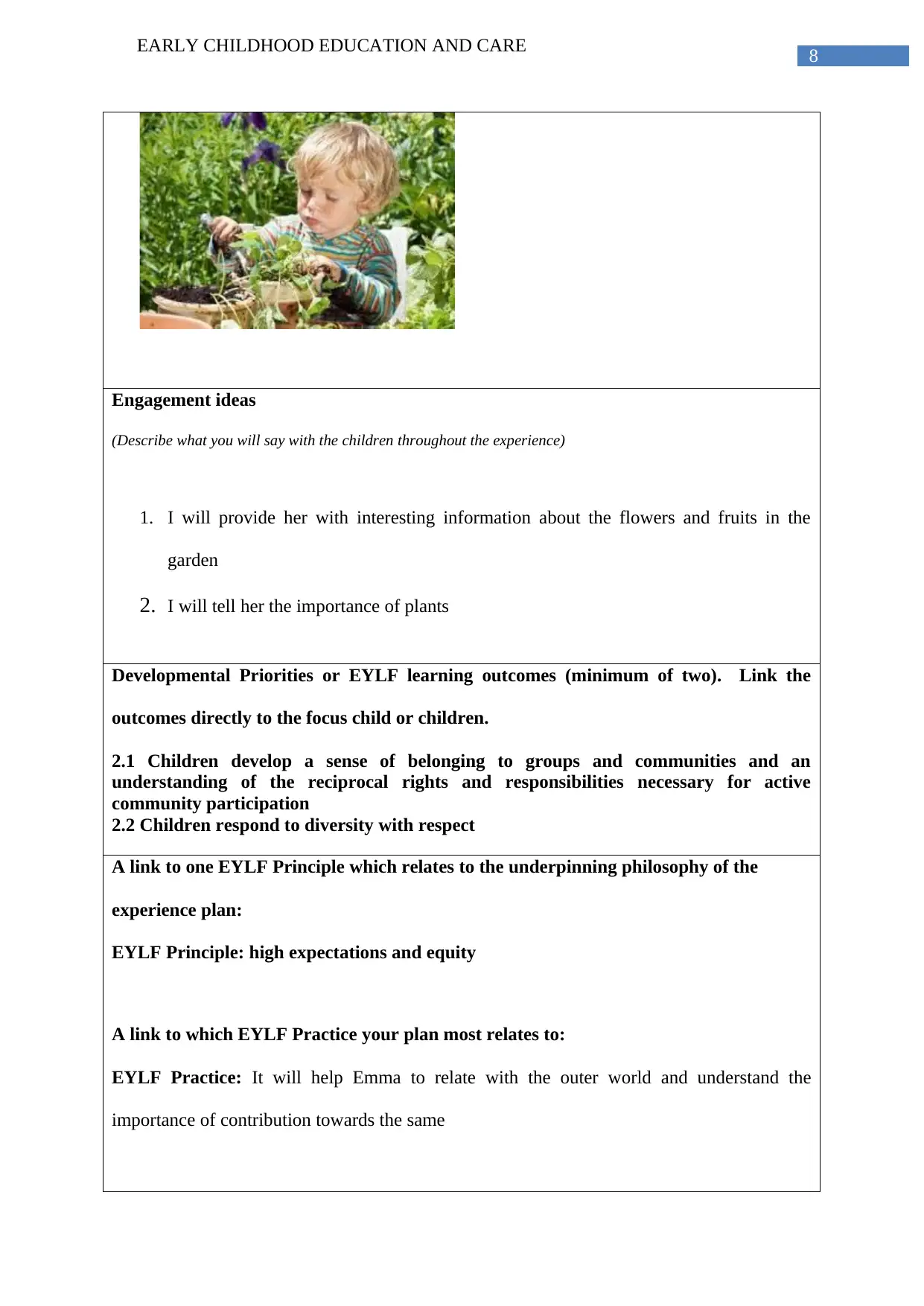
8
EARLY CHILDHOOD EDUCATION AND CARE
Engagement ideas
(Describe what you will say with the children throughout the experience)
1. I will provide her with interesting information about the flowers and fruits in the
garden
2. I will tell her the importance of plants
Developmental Priorities or EYLF learning outcomes (minimum of two). Link the
outcomes directly to the focus child or children.
2.1 Children develop a sense of belonging to groups and communities and an
understanding of the reciprocal rights and responsibilities necessary for active
community participation
2.2 Children respond to diversity with respect
A link to one EYLF Principle which relates to the underpinning philosophy of the
experience plan:
EYLF Principle: high expectations and equity
A link to which EYLF Practice your plan most relates to:
EYLF Practice: It will help Emma to relate with the outer world and understand the
importance of contribution towards the same
EARLY CHILDHOOD EDUCATION AND CARE
Engagement ideas
(Describe what you will say with the children throughout the experience)
1. I will provide her with interesting information about the flowers and fruits in the
garden
2. I will tell her the importance of plants
Developmental Priorities or EYLF learning outcomes (minimum of two). Link the
outcomes directly to the focus child or children.
2.1 Children develop a sense of belonging to groups and communities and an
understanding of the reciprocal rights and responsibilities necessary for active
community participation
2.2 Children respond to diversity with respect
A link to one EYLF Principle which relates to the underpinning philosophy of the
experience plan:
EYLF Principle: high expectations and equity
A link to which EYLF Practice your plan most relates to:
EYLF Practice: It will help Emma to relate with the outer world and understand the
importance of contribution towards the same
⊘ This is a preview!⊘
Do you want full access?
Subscribe today to unlock all pages.

Trusted by 1+ million students worldwide
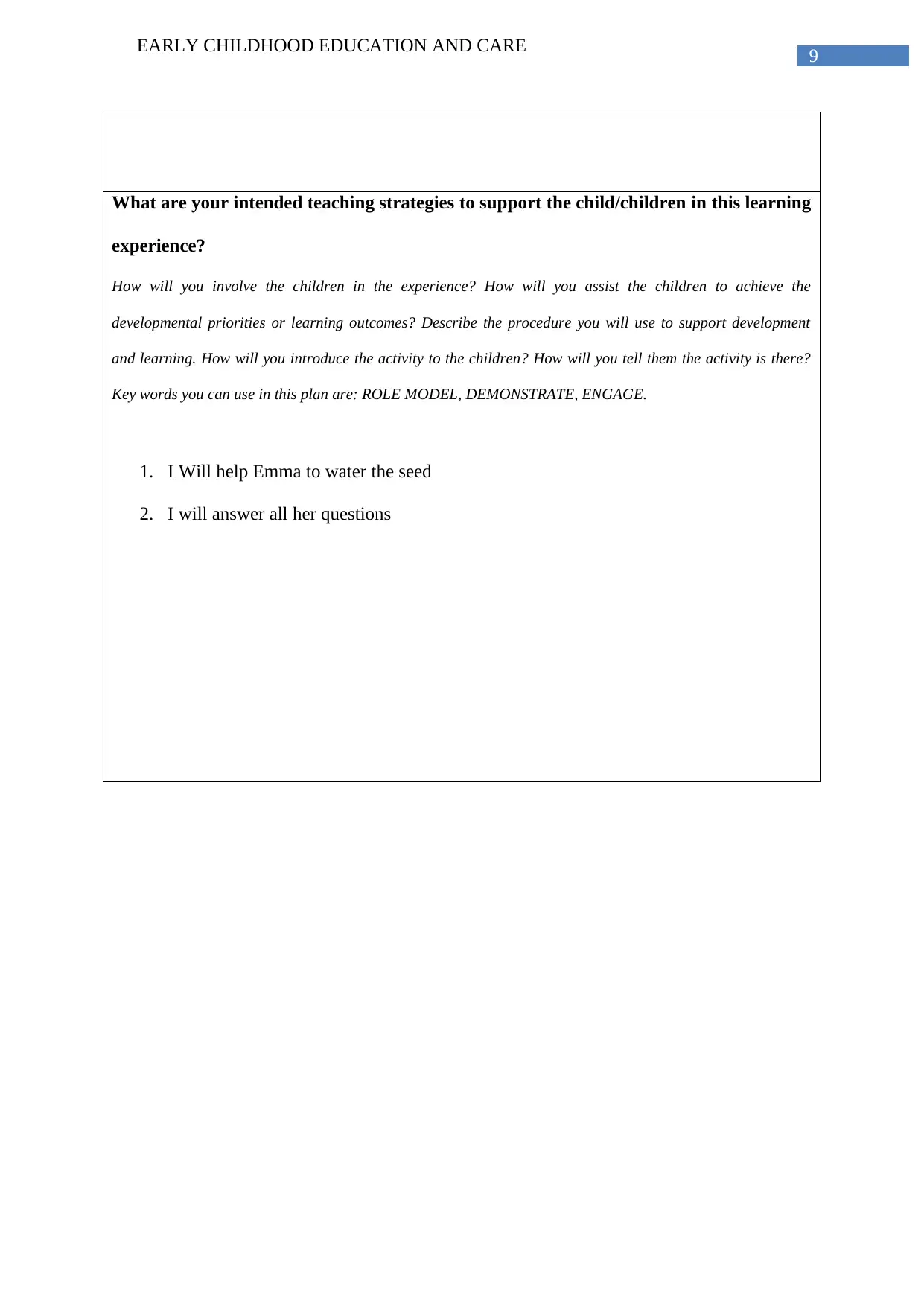
9
EARLY CHILDHOOD EDUCATION AND CARE
What are your intended teaching strategies to support the child/children in this learning
experience?
How will you involve the children in the experience? How will you assist the children to achieve the
developmental priorities or learning outcomes? Describe the procedure you will use to support development
and learning. How will you introduce the activity to the children? How will you tell them the activity is there?
Key words you can use in this plan are: ROLE MODEL, DEMONSTRATE, ENGAGE.
1. I Will help Emma to water the seed
2. I will answer all her questions
EARLY CHILDHOOD EDUCATION AND CARE
What are your intended teaching strategies to support the child/children in this learning
experience?
How will you involve the children in the experience? How will you assist the children to achieve the
developmental priorities or learning outcomes? Describe the procedure you will use to support development
and learning. How will you introduce the activity to the children? How will you tell them the activity is there?
Key words you can use in this plan are: ROLE MODEL, DEMONSTRATE, ENGAGE.
1. I Will help Emma to water the seed
2. I will answer all her questions
1 out of 10
Related Documents
Your All-in-One AI-Powered Toolkit for Academic Success.
+13062052269
info@desklib.com
Available 24*7 on WhatsApp / Email
![[object Object]](/_next/static/media/star-bottom.7253800d.svg)
Unlock your academic potential
Copyright © 2020–2025 A2Z Services. All Rights Reserved. Developed and managed by ZUCOL.




